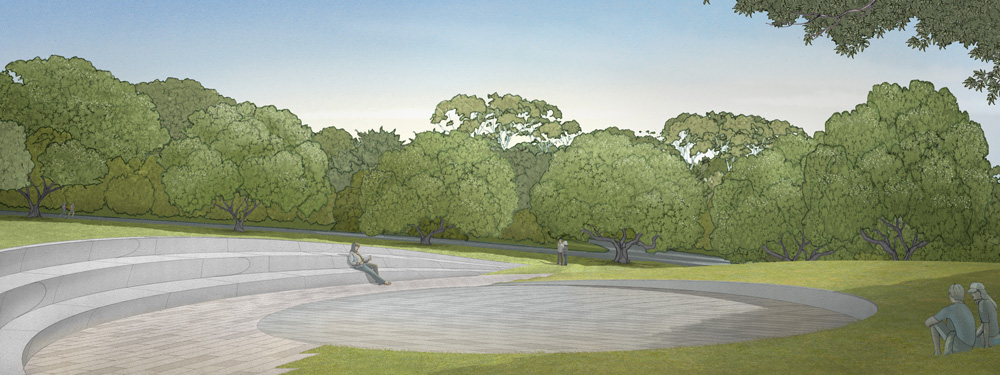Jun 3, 2016 Urban design
Above and below: The winning design, “Te Takuahi – The Hearth”. Illustration: Wraight Athfield Landscape + Architecture.
Critics of designs submitted for a new World War I memorial should have done some homework before opening their mouths.
Lest we forget, the design for a memorial in the Auckland Domain on the occasion of the centenary of World War I was never intended to be, as a Herald editorial had it, “something more to remind us of the war”. The distinction is up front in the design competition brief: “The feature is to be an exception to the normal concept of war memorials and to express the more personal and emotive impacts of conflict.” In other words, it wasn’t ever to be just another monument to fallen soldiers. What would be the point? When it comes to such statements about ultimate sacrifice and bravery, you can’t top the majestic 1929 museum on the hill on the edge of the crater of Pukekawa — the “hill of bitter memories” — in the Domain.
Acropolis-like in creamy-white Portland limestone from the Isle of Wight, strutting eight Doric columns apparently replicated from the Parthenon, it’s a splendidly neo-classical and monumental (some might say domineering, even fascist) presence. The Hall of Memories, its Sicilian white marble walls engraved with the names of 7297 Aucklanders who died in the Great War, is a war memorial making a powerful stand.
The new memorial costing $3 million ($1 million from Auckland Council over three years and the rest currently being sought from the Lottery Grants Board) should do something else: “The proposed feature or place should be a contemplative ‘stimulus to reflection’ about the effects of conflict on the wider community, and not solely on military service.”
In other words, a memorial for those who stayed home and also suffered in terms of loss and sacrifice. “It was really a place to reflect on the impact of wars on Aucklanders,” says councillor Sandra Coney, who chaired the political steering committee overseeing centenary commemorations. “One hundred years after the event, Aucklanders still remember the impact and grieve about it. This is still a very live issue.”
Councillor Mike Lee seems to have thrown his toys out of the sandpit … You have to wonder what planet he’s from.
As a commemorative concept it’s not without merit. Which makes the outrage and bah-humbug that followed the release of the five shortlisted designs late last year difficult to understand. As so often happens in this city, architectural debate quickly devolved to rabble-rousing and the inevitable mantra: waste of money, don’t need it.

How did it come to this? The answer is councillor Mike Lee. He has chaired the World War I Centenary Memorial Working Party since October 2014 and seems to have thrown his toys out of the sandpit.
Bizarrely, when the five shortlisted designs were revealed, Lee announced that none heeded the original brief. He also didn’t like their bicultural vibe. “We are talking about the Great War and the sacrifice made by the whole nation, so it is disappointing that key elements of the design brief have been ignored and Maori cultural themes have been emphasised so uniformly,” he told Stuff. You have to wonder what planet he’s from.
Or, as one commentator asked in response to the Herald’s misguided indignation: “How can those who have been tasked with overseeing the project be disappointed with the shortlist of ideas? Who created this shortlist if not those who are to oversee it?”
Lee, it seems, was convinced the brief was “to construct what is best described as a ‘processional way’, aligned on the museum’s central axis, down the northern grassy slopes before the museum to the Domain Drive”. In fact, the brief says no such thing — quite the opposite. “The new commemorative/contemplative feature must respect, harmonise with, and complement” the revered museum building. And must “respect and not visually compromise the formal ‘Close’” — the open green space fronting the museum. From its proposed location beside Domain Dr, the new memorial should connect with the old using “a visually recessive pedestrian linkage or way”. Lee, on the other hand, had become obsessed with the idea that the museum needed further neo-classical enhancement and has been poring over a ghastly expanse of tree-lined ceremonial pathway first proposed by city engineer James Tyler in 1932.
While some of the short-listed designs — such as Te Korowai, which envisaged the close as a ceremonial cloak of terraces — did create a processional way to the museum, Lee was nonplussed by their obvious Maori emphasis. He remained displeased when the winning design was chosen. “Te Takuahi — the Hearth is a standalone feature which has no functional role for pedestrians and may well become a skateboard park and repository for rubbish,” Lee told Stuff.
The design by Wraight Athfield Landscape + Architecture, in conjunction with Auckland artist Ross Hemera, touches lightly on the existing landscape. Comprising a 35m-diameter circular platform, created by terraces both cut and raised into the grassy slope, Te Takuahi makes a quiet stand. It connects to the Domain Dr footpath by an unobtrusive reinforced grass pathway. But by far its most tantalising aspect is its promise of fire, either as a performance (think swirling fire poi) in the 15m-diameter inner paved circle or as a beacon to be lit on commemorative occasions.
As a bicultural represent-ation of keeping the home fires burning (ahi ka) combined with the idea of the eternal flame of remembrance, it’s hard to imagine a better “stimulus to reflection” on the effects of war. What a terrific, fiery and powerful addition such a feature would bring to our skyline. Auckland Council should ignore the Mike Lee time warp and make it happen.





